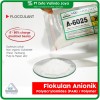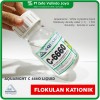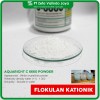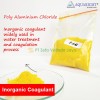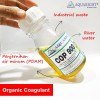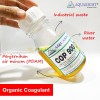What Chemicals Are Needed for Wastewater Treatment?
Comprehensive Solutions for Wastewater Treatment with AQUARIGHT Specialty Chemicals

WWTP (Wastewater Treatment Plant) is a facility designed to treat wastewater generated from industrial activities before it is discharged into the environment. The primary goal of a WWTP is to reduce water pollution to levels safe for environmental discharge, thereby protecting ecosystems.
The wastewater treatment process generally consists of several stages:
- Primary Treatment: Aims to remove coarse solids and settle solid particles. This involves physical/chemical processes including grit removal, equalization, coagulation, sedimentation, and pH adjustment.
- Secondary Treatment: Biological processes for decomposing organic materials by microorganisms. This stage includes aerobic, anaerobic, facultative, and combination processes.
- Tertiary Treatment: Advanced treatment using physical/chemical and biological processes to remove specific pollutants such as nitrogen, phosphorus, and heavy metals through technologies like nitrification, denitrification, ozonation, filtration, and adsorption.
Challenges and Common Issues in Wastewater Treatment
- High Levels of Organic Matter: High concentrations of organic substances like fats, oils, and proteins in wastewater can be difficult to decompose, causing various problems such as decreased dissolved oxygen (DO) levels. Microorganisms decompose organic materials using oxygen, and if organic matter is too high, it can deplete oxygen, leading to anaerobic conditions. This promotes anaerobic bacteria growth, producing toxic gases like methane and hydrogen sulfide and causing unpleasant odors. High organic matter also leads to excessive sludge formation and increased biochemical oxygen demand (BOD).
- Presence of Hazardous Pollutants: Industrial wastewater often contains hazardous substances like heavy metals, persistent organic compounds, and pathogens. Some pollutants, such as strong acids or bases, can damage wastewater treatment infrastructure.
- Load Fluctuations: Pollutant loads in wastewater often fluctuate, making it difficult to control treatment processes. Fluctuations can be due to seasonal changes, rainfall increasing wastewater volume, changes in industrial activity, and other factors.
- Sludge and Sediment Formation: Accumulated sludge and sediments can clog pipes, channels, and other equipment, disrupting wastewater flow, reducing process efficiency, and even causing equipment damage. Gradual sludge and sediment accumulation also decreases the effective capacity of settling tanks, aeration tanks, and other components, impairing the system’s ability to treat the same volume of wastewater.
- Unpleasant Odors: Some types of wastewater produce unpleasant odors due to decomposition processes. Decomposing organic matter in sludge also generates foul-smelling gases like ammonia, hydrogen sulfide, and methane, disturbing the surrounding environment and posing health issues.
Why Are Chemicals Needed in Wastewater Treatment?
Chemicals play a crucial role in enhancing the efficiency and effectiveness of the wastewater treatment process. Key functions of these chemicals include:
- Decomposing Organic Matter: Fat-degrading chemicals help break down fat molecules into smaller particles, making them easier for microorganisms to decompose.
- Accelerating Sedimentation: Coagulants and flocculants help agglomerate small particles into larger flocs, making them easier to settle.
- Neutralizing pH: pH adjusters are used to set the wastewater pH to optimal levels for microorganism growth.
- Preventing Foam Formation: Defoamers reduce foam formation that can interfere with aeration processes.
- Killing Pathogenic Microorganisms: Disinfectants are used to kill bacteria, viruses, and parasites in wastewater.
AQUARIGHT Specialty Chemicals for Optimal WWTP Performance
AQUARIGHT Specialty Chemicals offer a range of specialized chemical products designed to address various issues in wastewater treatment.
- AQUARIGHT Bio-Degreaser Tab : Effectively tackles fats and oils in wastewater, preventing pipe blockages and enhancing treatment efficiency. Added at the initial stage to break down fats before entering the biological system.
- Bacteria Concentrate AQUARIGHT N 602 : High-quality bacterial concentrate that accelerates the decomposition of organic materials, boosting biological system performance.
- Bio Nutrient AQUARIGHT N 820 : Balanced nutrients supporting bacterial growth, ensuring optimal treatment processes.
- Disinfectant AQUARIGHT Sod. Hypochlorite dan Chlorine (Cair/Tablet) : Strong disinfectants for killing pathogens and maintaining the final wastewater quality.
- AQUARIGHT Defoamer 10 : Addresses foam issues that disrupt treatment processes, enhancing aeration efficiency.
- pH Adjuster AQUARIGHT A 055 : Maintains optimal conditions for microorganisms and chemical processes.
Pengatur pH untuk menjaga kondisi optimal bagi mikroorganisme dan proses kimia. - Coagulant AQUARIGHT KP 35 AC dan AQUARIGHT COP 900 : Effective coagulants for settling suspended particles, improving wastewater quality.
- Flocculant AQUARIGHT A 6025, AQUARIGHT C 6660 : Aid in forming dense flocs, accelerating sedimentation and clarification processes.
Using the right combination of AQUARIGHT Specialty Chemicals enables WWTPs to achieve optimal treatment efficiency, producing cleaner wastewater and minimizing environmental impact.
For further consultation, please contact us at +6221 8873 531, or email info@zevanya.com.


